A Boxer dog is a lean muscular dog who gives out a robust aura but is really sweet and loving in nature.
It is a medium-sized breed whose maturity doesn’t hit till the age of 3 giving you a full grown boxer with a puppy-like charm.
Originally bred for guarding, this breed is fierce and faithful to their guardians.
It loves to be with its keeper all the time and due to the fact that it has a lot of energy, it loves to stay busy most of the time of the day.
If you are looking for a breed that can be trained well and has a lively vibe, then Boxers are a perfect match.
Table of Contents
Quick Facts
Avg. Weight: 60 – 80 pounds (male); 50 – 65 pounds (females)
Avg. Height: 24 inches (male); 22 inches (female)
Life Expectancy: 10 – 12 years
Dog Group: Working Dog
Colors: Brindle, White, Fawn
Dog Rank: 10/193 (America)
Boxer Pictures
At a Glance
Size (3/5)
It is a medium-sized dog loaded with compact muscles and can weigh from 50 lbs to 80 lbs depending upon gender, genes, and food given since its early days.
It has an athletic look and seems like its flexing and showing off its muscles most of the time.
Affection Level (5/5)
Don’t go on this breed’s tough façade, it is much more loving than you think.
It loves to take its keeper’s time as much as possible and expresses signs of sadness when not paid much attention.
It is one of the best breeds to have in a family household as it attaches itself strongly to all the members and never runs out of energy to love and play with each of them.
Apartment-Friendly (4/5)
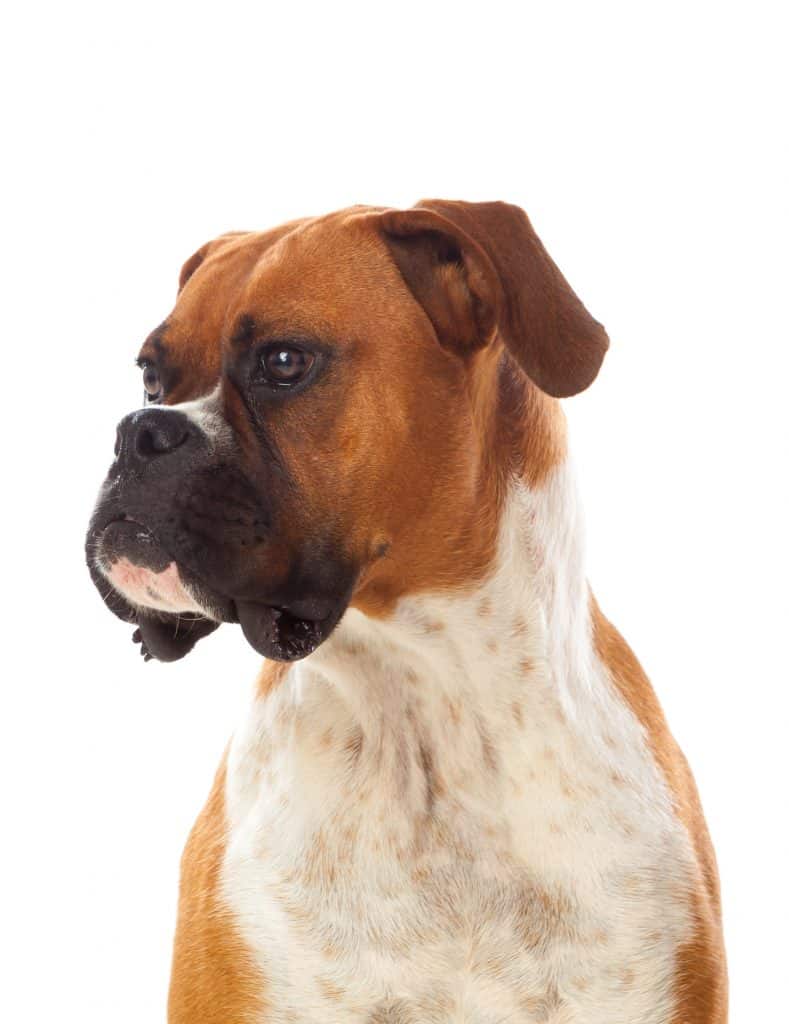
Although energetic and having a hype personality, this breed doesn’t need a yard attached to your home.
You would find it chilling beside you while you skim through a magazine or watch your favorite TV show.
Yes, it likes relaxing a lot making it one of the least disturbing elements in a house.
Do not feel guilty about not providing your boxer with that much-needed openness as taking it down to play or a walk is enough to satisfy its hunger for the venture and to retain its liveliness.
Cold Weather Tolerability (2/5)
Boxers and winters don’t go along well.
Due to the fact that boxers have a thin coat, it is hard for them to keep warm at low temperatures.
You should refrain from keeping any dog, let alone a boxer, out in the cold for long, even if you have a shed built for it in your yard.
In temperatures like 32oF, a boxer can be made to walk outside for 20- 30 minutes 2 to 3 times a day but being an owner it is your task to get it covered with a jacket or a warm coat.
Hot Weather Tolerability (1/5)
One of the boxer traits is that its body is incapable of properly regulating the body temperature and so any amount of shade outdoors will serve to be insufficient under the hot summer sun.
Don’t take it out for a walk for more than 20- 30 minutes in summers and make your pooch drink a lot of water to prevent dehydration.
Summertime hack is to take your dog out early in the morning and in the evening, around the time when the sun is not so harsh.
Barking Tendency (3/5)
It is seldom that you see a boxer yapping for no reason.
Boxer dog temperament is generally well with everyone familiar.
Boxer dogs are very intelligent and you will find them barking only when they feel that their abode is threatened.

This happens generally when an unfamiliar face visits your home.
A boxer takes its time to analyze a person to determine if he/she is not a threat and puts its guard down the instant it feels there is nothing to get bothered by.
Cat-Friendly (3/5)
Boxers are pretty charming at socializing with almost all animals and can be overwhelmingly playful with them.
Cat owners need not worry about getting a boxer puppy but do go through the dog’s history when adopting an adult.
Boxers, if never given the space for socializing can depend on their instincts to respond to other animals and so it can be fatal for cats.
Dog-Friendly (3/5)
Boxers are the kind of dogs who like to take dominance over others and so they require a strong owner who can effectively keep them under control and train them to keep cool with other dogs.
Socializing your boxer since its early days can make it really playful with other dogs and so make sure to give it space and environment to develop that way.
Exercise Needs (5/5)
This pooch needs to play a lot out in the park so as to not spend its energy being destructive indoors.
Boxers are an energetic breed and require at least an hourly walk per day or a good game of fetching a ball/Frisbee.
Boxer puppies need a 20 min walk per day to stay healthy.
Take your boxer to the dog park or make it play with kids and neighbors as much as possible since puppyhood so that it doesn’t grow aloof.
Grooming Needs (5/5)
Grooming a dog can be very time consuming and tedious but not in case of a boxer, its short-haired thin coat can do well without being taken care of for days.
Unless your boxer comes home covered with mud out of some shenanigan, you only need to bathe it once in every 15 to 20 days.
Its heavy grooming demands come only at the time of changing the season.
At this time boxer shedding is common and also heavy, so make it a routine to brush your pooch with a shedding blade, remove excess dead hairs to prevent your home from becoming a hairy mess.
Make sure you use the best shampoo for boxers, and you won’t find a good shampoo in any store as the use of sulfate is high.
You can quickly make a dog shampoo at home by reading this dog shampoo DIY.

Playfulness (5/5)
Yes, a boxer is all time ready to play and its level of energy makes it unstoppable in the playground.
Its gentle and loving nature makes it mingle with kids very well and can be a full-time playmate to them.
Leave your boxer with a ball and you will find it playing and pawing the ball like a cat and keeping busy.
Trainability (3/5)
Are boxers easy to train, on one hand, boxers are quick to learn the basic commands and need relatively less repetition of actions to start responding well, but on the other, they are a little stubborn when it comes to following their instincts?
To keep a boxer from taking instinctive actions, the keeper of the dog has to be the alpha dog in the house and take charge of it.
Keeping your dog in a socializing environment since its puppyhood is the best training it can ever receive to behave itself anywhere.
Intelligence (4/5)
This breed is fairly intelligent and it is due to this fact, this dog comes under the category of ‘working dog’.
There is always a reason behind a boxer’s bark.
These dogs have a really good decision-making tendency and can be trained well, that’s why these dogs are also used in the police force or such disciplines.
Mouthiness (2/5)
Unlike other dog breeds, boxers are not that mouthy but yes some amount of mouthiness should be expected from any breed.
It is highly unlikely that you find your boxer chewing on the sofas or the curtains.
A chew toy can take care of this little trait of your dog.
Price Group (4/5)
Boxer dog price can be a little costly when bought from a reputed breeder, which can range from $800 – $2800.
But, if you are looking to adopt a boxer, it may only cost about $300- $400.
Boxers have a tendency to stand on hind legs and “box” with front paws and so the name ‘Boxer’.
About Boxers
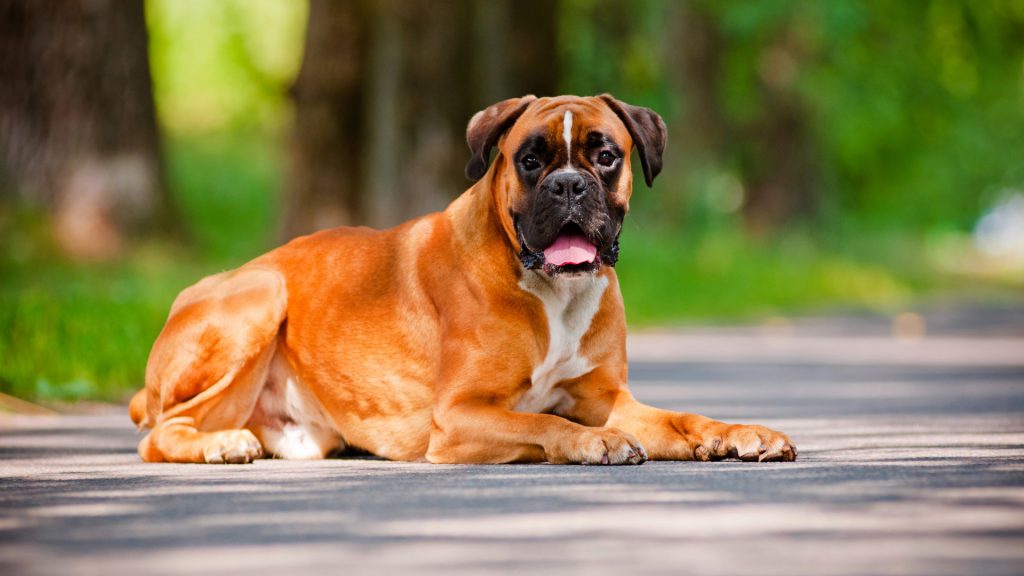
Boxers are a breed that has lean muscular exterior giving out a poised persona.
Although tough by looks, these dogs have a soft corner for the ones familiar.
It is a powerhouse with unending stamina and an ever-ready nature for playing and it can keep all the family members at their toes turn by turn throughout the day.
It can also turn into a couch potato after a good hour of play.
It is very loyal and devout to its owner and family and can assume the stance of a watchful guardian whenever it feels uncertain about someone.
It is loving and puppy-like till the age of 3, making it a breed with longest lasting puppyhood.
It is a pretty intelligent breed and so it can be trained well.
Also, it can get along with most all if given a proper social environment since the start or else it can grow up to be aloof, a dog running on instincts.
Overall it is a very charming breed to have at home and is the 10th most preferred breed in America.
History Of Boxer Dogs
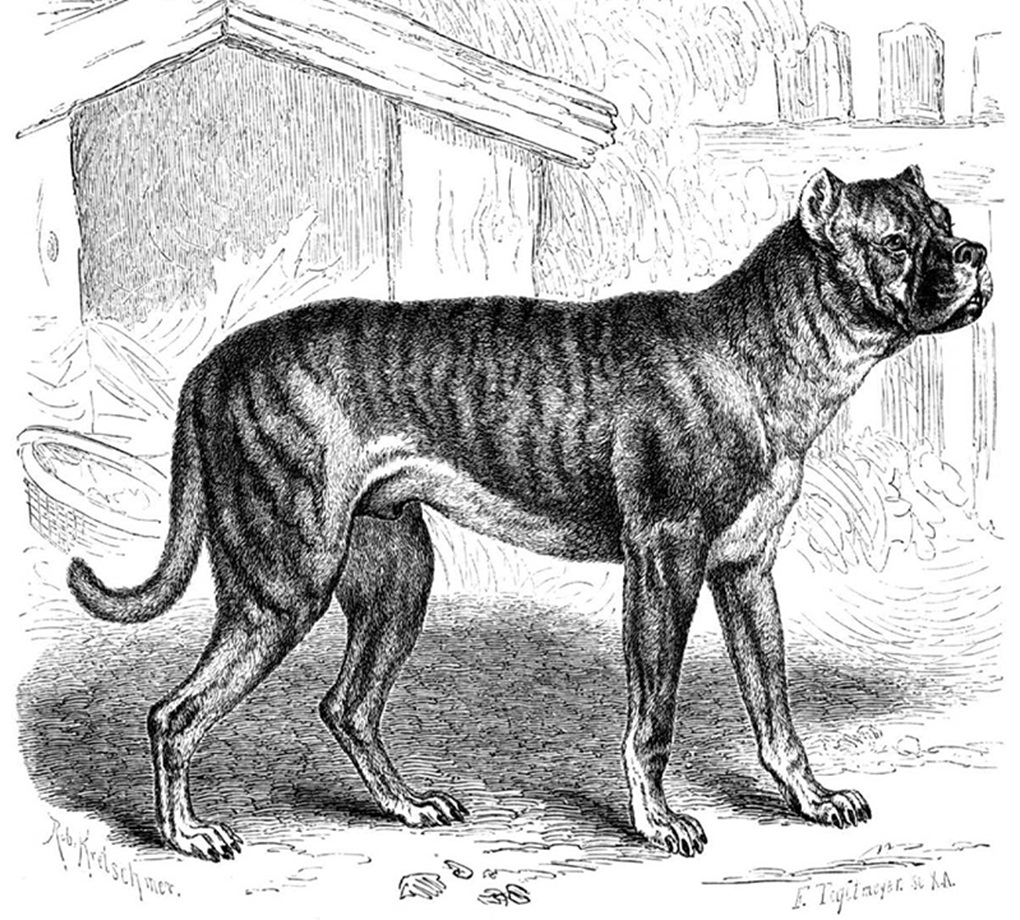
Boxers as a breed originated from Munich, Germany in the early 19th century.
This breed is the consequence of cross-breeding of terrier, Great Dane, mastiff, bulldog and the now extinct breed of dog ‘bullenbaiser’.
Boxers are mainly linked to bullenbaisers who were used as hunting dogs to hunt down bears, deer and wild boars.
When this breed was brought to light, it was initially used to help the butchers for handling their cattle.
As times passed by, humans came to acknowledge the breed’s intelligence and fierceness, and the breed started making appearances in many disciplines of law enforcement.
Its loyalty and allegiance to the trainers gave it away into their homes.
This is where it’s loving nature and highly flexible social behavior was noticed making it a commoner among the breeds seen in family households.
Size
A boxer can grow as much as 21 to 25 inches tall, taking its place among the medium sized breeds of dogs.
It can weigh from 50 lbs to 80 lbs depending on the gender.
Its growth like any other dog breed is also dependent on its genes and quality of food given to it since its puppyhood.
One boxer holds the world record for having the longest tongue in the world at 17 inches long.
Trainability
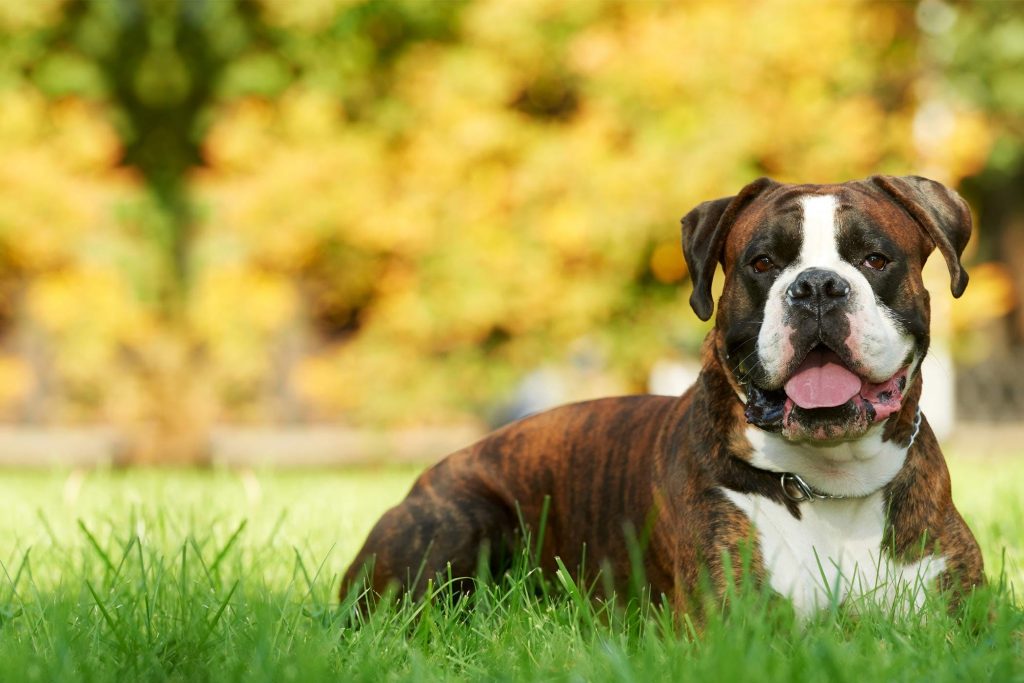
Boxers are intelligent dogs and fairly easier to train unless the training is about controlling their instincts.
If you want to keep a breed like a boxer in your house, you would have to take charge and be the alpha dog to have command and control over your pooch’s instinctive actions.
A boxer can be pretty adamant in following its instincts (if grown in seclusion) and so as an owner, it is your job to make it socialize with all since the puppyhood.
Apart from that, it is pretty quick at grasping basic commands and learning the ways of a household.
Grooming
Boxers are low maintenance dogs who require a bath once every 15- 20 days.
Due to their short hair coat, they don’t even require brushing every day, though you must or at least brush them every alternate day for 5 to 6 minutes.
They don’t carry a strong body odor unlike some breeds that if kept at home can make the guests guess if you own a pooch.
Your task of grooming only gets heavy with the changing weather.
At this time, boxers start shedding heavily and so brushing them every day and removing their dead hairs can help in keeping your house clean.
Most of the task of grooming is covered by your boxer as it is one among the breeds who keep themselves clean and tidy.
Feeding

A boxer weighing 50- 80 pounds should have 4- 5 cups of meal and 75 to 120 ounce of water per day.
Food should involve chicken beak and animal paws along with meat.
Always include good quality commercial dog food in your dog’s meal as this food is processed taking into consideration all vitamin and mineral requirements of a dog.
You can also find commercial dog food made for specific breeds.
You can also include vegetables like broccoli, leafy greens, potato, carrots, asparagus and many more.
Suggested: Senior Dog Food
| What Should Be Fed | What Should Not Be Fed |
| Milk | Macadamia Nuts |
| Peanut Butter | Alcohol |
| Egg | Coffee |
| Tuna | Avocado |
| Rice | Dough |
| Mangoes | chocolate |
Common Diseases
Cancer
Boxers are prone to cancer of the skin, lymph nodes, tumors of the brain and spleen.
Do not take a boxer with big white patches outside for a walk under the strong sun as it can cause skin cancer in them.
Boxer cardiomyopathy (BCM)
It is an inherited condition which can lead to erratic changes in the heartbeat of the dog causing it to lose consciousness, feel week, or in extreme conditions death.
It is a condition that passed from under the radar without any signs and can cause sudden death.
Boxers having this condition shouldn’t be bred.
Colitis
Or simply an inflammation of the colon is pretty common in boxers.
Its symptoms are diarrhea and release of a mix of mucus and blood which can make the dog pale and shed its weight down.
It can be treated and isn’t of any major concern.
Other common diseases found in boxers include alopecia, hypothyroidism, hip dysplasia, and stomach bloating.
FACT-ILICIOUS: White boxers are prone to being born deaf and often have many skin issues.
Vaccination And Care
Always monitor your boxer’s behavior because a sudden change in its temperament or attitude can be due to some uneasiness being caused inside its body.
Take it to the vet every 2nd month for a complete health checkup and ask the vet to recommend a diet or any change in the routine.
Meet all of its grooming requirements for every day as it is not a hectic task to do so.
Keep it physically active and play with it to keep it from growing obese.
Vaccines against distemper, parvovirus, hepatitis, parainfluenza, leptospirosis, and rabies are an absolute necessity and should not be skipped.
Read Our Guide To Dog Vaccination to have an in-depth idea of vaccines.
Monthly Expense Estimation
A monthly expense can vary depending on the size and other factors of a boxer.
Dog food and treats generally cost $30- $60 per month.
The 1st year of adoption is a little costly and all the vaccinations, health checks, food, and miscellaneous requirements can cost up to $1300, but after that $500 per year sufficient to cover its needs.
A visit to the vet can cost around $80 which is not required every month.
On an average $65- $85 per month are enough to suffice a boxer’s needs.
Behavior With
Children
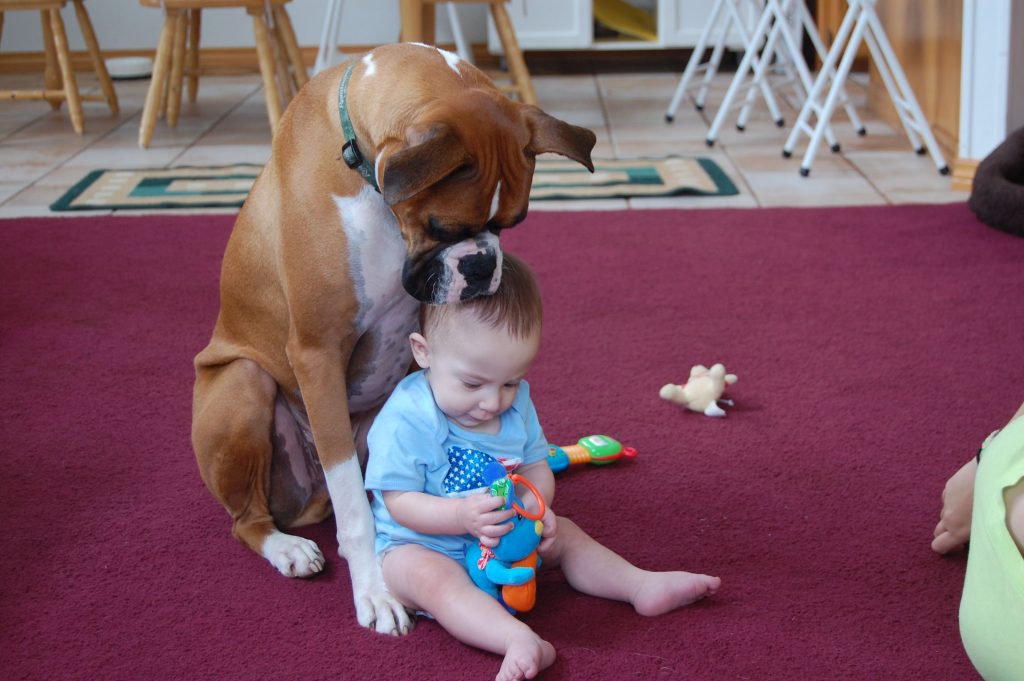
Boxer is a loving pet that forms a great bond with humans and especially the members of its household.
It is also great with kids as both share endless energy levels for playing.
It can keep your kids busy in the yard and loves playing games like fetch or with a Frisbee.
The only boxers you would ever find threatening to the kids are the ones who haven’t been properly socialized since the start and have grown aloof.
Dogs
You will mostly find a boxer growling over other dogs of the same sex.
Like said before, this breed is highly flexible in mingling with other animals but all it requires is a good social environment to grow in.
Boxers who have been given the right kind of training and environment since the start can be overwhelmingly playful with other dogs.
Cats
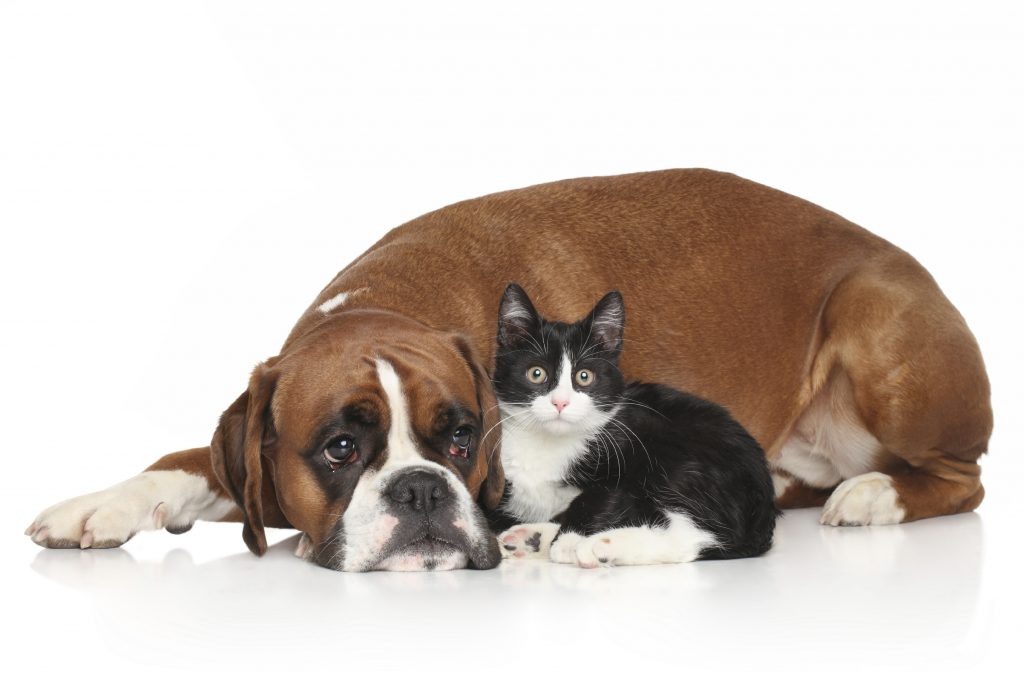
Yes, this breed does well with cats.
You might find your boxer not moving from the sofa when your cat is sleeping over it.
It gets that caring for a house cat.
It can be dangerous for your cat only if not grown with one or never been made to mingle with one, which makes it dependent on its instincts to react towards the cat.
In that instance, it can see your cat as prey.
Overview

The breed originated from Germany and was initially used for controlling cattle by butchers.
Due to its intelligence and flexibility in training, it started to be commonly used for guarding purposes.
It is a lovely breed and 10th in America’s favorite breed list.
It has a high tendency to mix and mingle with almost all only if provided the right training and kept under regular interaction with other animals.
It is a regular sized breed and packed with energy.
It needs an hour’s play every day to be content and relaxed indoors.
It is loyal and devout towards its keeper and members of the household.
It has very low grooming requirements and also looks after its cleanliness almost like a cat.
Its monthly expenses aren’t that costly and cost around $65 per month.
It does great with kids and neighbors unless aloof.
What are your thoughts on a boxer?
What common good/bad traits of boxers have you heard from their owners?
Let us know in the comment section below.



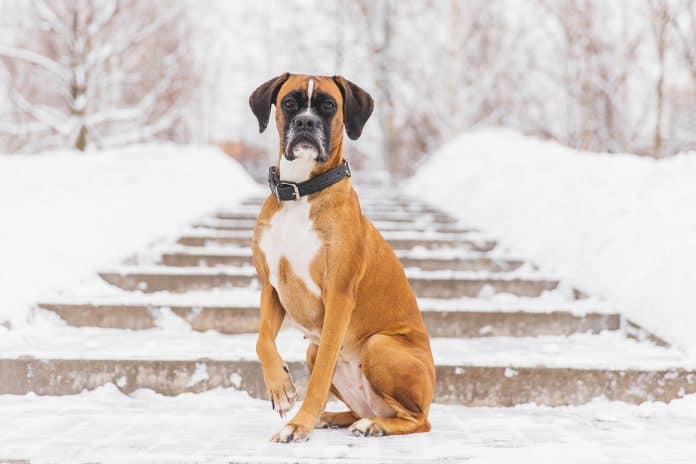


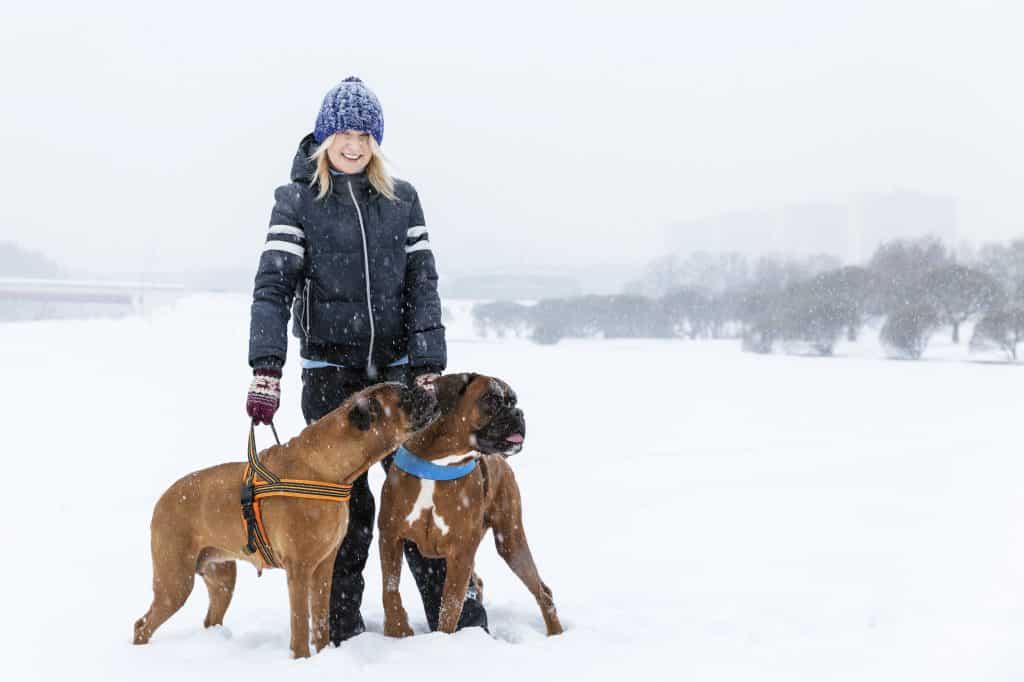









[…] Boxer […]
[…] Boxer […]
[…] this article, we will present some interesting facts on Boxer dogs . The Boxer is today’s one of the most famous dogs, especially in the United […]
[…] Boxer […]
[…] 7. Boxer […]